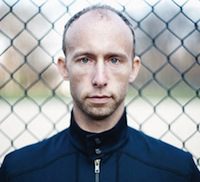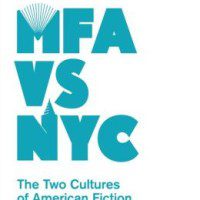A brief refresher in philosophy and linguistics: Any category we make in order to understand an object or experience will itself change the object or experience. A succinct explanation of this phenomenon appears in George Lakoff and Mark Johnson’s Metaphors We Live By, and here’s an example from my bookshelf: (1) I’m reading a book about American fiction, (2) I’m reading a collection curated by a bestselling novelist, (3) I’m reading a bunch of essays, and (4) I’m reading a lot of previously published—and some naysayers might say warmed-over—arguments about creative writing in the twenty-first century.
Just as the Marxist, lesbian, sexy blonde, and renowned cellist invited to Lakoff and Johnson’s dinner party turn out to be the same person, the categories above describe the same book: MFA vs NYC: The Two Cultures of American Fiction. The book—named for editor Chad Harbach’s insightful, widely circulated 2010 essay—starts by taking the complex world of American fiction and reducing it to a two-sided acronym fight between graduate programs and publishing houses in New York City. University workshops, modeled on the Iowa Writers’ Workshop, have grown 673% since 1975. The five big publishing companies, according to Harbach, have become conservative and now prefer to publish only sure-fire blockbusters.
As a categorization system, MFA vs. NYC presents immediate and obvious problems. Like all capital-letter dichotomies—Good vs. Evil, Science vs. Religion, Republican vs. Democrat—one exception destabilizes the entire schema. Harbach doesn’t exactly fall into that trap. In his introduction, he acknowledges his categories aren’t monolithic, even though they sound that way, and describes them as a two-headed monster “in which the two heads are always chatting and bickering and buying each other drinks.” But the bigger problem is that MFA and NYC aren’t just two circles on a Venn diagram where some examples overlap. As Mark McGurl points out in The Program Era, his dizzying, electrifying criticism and celebration of postwar creative writing, the pitched battle over creative writing in America is over, or maybe it never happened.

For one thing, the university-dominated workshop model has spread far beyond the Ivory Tower, and its influence extends to agents and editors working at the big houses, because MFA graduates or professors write most of the submissions they read. Even bestselling novelists—those who ostensibly write the blockbusters that New York publishing craves—now teach and write in mini-workshops at writing retreats across the country. The Tin House Summer Writer’s Workshop is a good example. Dennis Lehane and Sterling Watson’s Writers in Paradise, which I once attended as a student, is another. A pair of essays in MFA vs NYC, “Money (2006)” and “Money (2014)” by Keith Gessen, describes a similar kind of evolution, from making a living as a writer to making a living teaching writing.
The concinnity between MFA and NYC might explain why almost every selection has more to do with the now-ubiquitous workshop model than with publishing. Out of 19 essays and interviews in MFA vs NYC, 12 deal directly with the MFA or the teaching of writing. Almost all of them mention it at least once. Even the essays in the NYC section sometimes blur into a discussion of workshop writing, as with “People Wear Khakis,” an interview with Lorin Stein, editor of The Paris Review, whose first three pages are about his time in the poetry program at Johns Hopkins. The same is true of Melissa Flashman’s entertaining and well-written essay “How To Be Popular,” which spends about two pages describing “MFA novels” and “fiction that didn’t come from MFA-land but shared its themes,” like Khaled Hosseini’s The Kite Runner.
This isn’t to say everyone in the book celebrates creative writing programs. Far from it. Eric Bennett’s “The Pyramid Scheme” uncovers a secret history linking the Iowa Writers’ Workshop to the CIA, which, according to Bennett, partially helps to explain a conservative tendency in workshop stories. David Foster Wallace foresaw something sinister in MFA programs, too—part of his 1988 essay “Fictional Futures and the Conspicuously Young” appears in MFA vs NYC. He writes about the “dark side” of creative writing programs, from “publish-or-perish” to “faculty power struggles that summon images of sharks fighting for control of a bathtub.” It’s Wallace at his incisive, hysterical best, and his voice echoes even five years after his death, but it also begs a question: If MFA degrees are so terrible, what do we do now that, over twenty years after his original essay appeared, they’ve become inseparable from the fabric of American fiction?
Do all writers, programs, and books fit somewhere on a continuum between MFA or NYC? The answer, as Harbach knows, is no. American fiction is one thing, not two. Dividing it into two cultures is as strange and artificial, in its way, as dividing the ocean on a map. Yet the distinctions are natural and in some cases essential, as long as we don’t forget that we made up these categories in the first place. The true, important achievement of MFA vs NYC is advancing an ongoing conversation about fiction begun by The Program Era. How does art flourish in an environment of institutional creativity? How do writers make money and produce literature at the same time? No one will agree with everything in the book, of course, but that’s not the point. What matters is the conversation. And with its many ideas and voices, MFA vs NYC makes an essential contribution.




